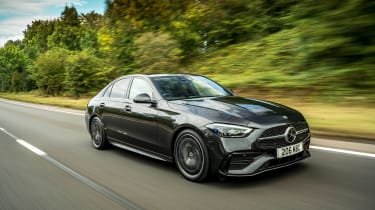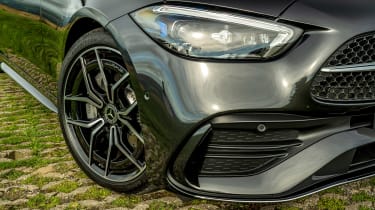Mercedes C-class review – BMW 3-series rival strikes back
Concrete evidence that long-standing engineering garners excellent results. The C-class has never been better
Amongst the myriad of new car varieties being churned out by the industry at large thanks to an automotive ecosystem moving towards electrification, there’s something very comforting about an all-new version of a model that’s been a constant for nearly 40 years. The Mercedes C-class is one such car, spiritually unchanged over its lifetime, and still the ‘real’ entry point to the Mercedes range.
But to confuse this steadfastness with a lack of innovation would be a mistake, because the C-class’s evolutionary path has meant that almost all of its rough edges have been shaved off to become, in this fifth generation, a frankly brilliant compact executive saloon and estate that operate over and above their mandates, and probably their price points too.
Some concessions have been made to the current automotive climate – it’s only available with four-cylinder engines for instance, and hybridisation has now been applied across all models, whether that be in mild or plug-in forms. Yet, for the first time the use of electrification is starting to yield results, as real progress has been made in terms of efficiency and integration to a point where you would miss it if it were gone. The mainstream car world might be turning to pure electric, but right now there are few better ways of getting around than in a C-class.
Mercedes C-class: in detail
- Engine, gearbox and technical highlights > All petrol and diesel fours come with either mild or plug-in hybridisation
- Performance and 0-62mph time > All engine options perform well; 300d models feel more brisk than they need to be
- Ride and handling > Something Mercedes consistently improves with every generation, the W206 is now not just capable, but also entertaining
- MPG and running costs > Widespread hybridisation makes all new C-classes more efficient and less expensive to run
- Interior and tech > A huge jump in perceived quality and design, but you’ll have to like touchscreens
- Design > An inoffensive and sleek design that’s undone slightly by some garish detailing
Prices, specs and rivals:
The C-class might only be available with four-cylinder engines in this generation, but the pricing structure hasn’t deviated from the current trend of inflated list prices due to a high take-up of leasing. So far, UK models are limited to a total of five powertrain variations in either Sport or AMG Line trims, the latter then having additional Premium and Premium Plus packages available depending on the powertrain.
More reviews
Prices for the base C200 petrol in Sport trim start at £38,785, with the C200d costing a further £2000. C300, C300e plug-in hybrid and C300d models are only available in AMG Line trim starting at £43,500, £44,895 and £45,925 respectively, making the plug-in hybrid (inexplicably) less expensive than the diesel. All Sport and AMG Line cars come with a solid specification, including Merc’s big new touchscreen interface, digital dial pack, heated leather seats, LED headlights and a reversing camera. AMG Line cars up the exterior jewellery with new bumpers, bigger 18-inch wheels and some extra brightwork. The interior also picks up an upholstered dash and privacy glass.
Models fitted with the Premium pack cost an extra £2750, which ups the wheel size another inch to 19 inches, and upgrades components of the interior ambient lighting, MBUX interface and parking assistant. The big gain is an upgrade to Merc’s fantastic Digital Light headlights that first debuted on the new S-class. The Premium Plus will add a further £3450, bringing a different 19-inch wheel design, panoramic sunroof, a huge head-up display and four-zone climate control. Estate models are available in all the same trims and options at a £1635 premium.
As for rivals? Well, there’s the BMW 3-series which mimics the C-class’s specification in large part with a £1k or so price advantage. The 3-series’ mild-hybrid electrification isn’t as widespread, but it has a six-cylinder M340i at the top of the range to compensate. Mercedes will have a mid-level AMG model to rival the M Performance BMW eventually, but it’ll run a four-cylinder petrol, again with hybrid assistance. Plug-in C300e versus plug-in 330e runs things close in terms of power and performance, but the Mercedes has a much longer all-electric range at around 70 miles on the WLTP cycle, double that of the BMW.
Audi’s A4 enters the ring with one arm behind its back as it’s a model that’s coming to the end of its lifespan, explaining a total lack of any hybridisation. A4s drive well enough and their interiors are still superbly built, but the BMW and Merc have opened up considerable leads in both areas. If you’re into a big six-cylinder diesel, though, an A4 3.0 TDI remains an all-rounder that’s tough to beat.
Alfa Romeo’s Giulia is still fantastic to drive, but now feels multiple generations behind in regards to tech and powertrains, and the same could be said of the Jaguar XE and the Genesis G70.







